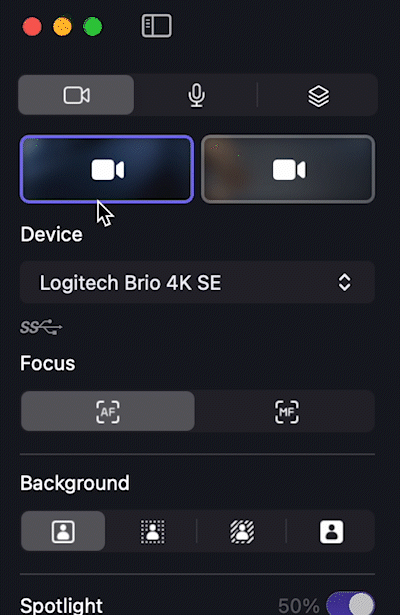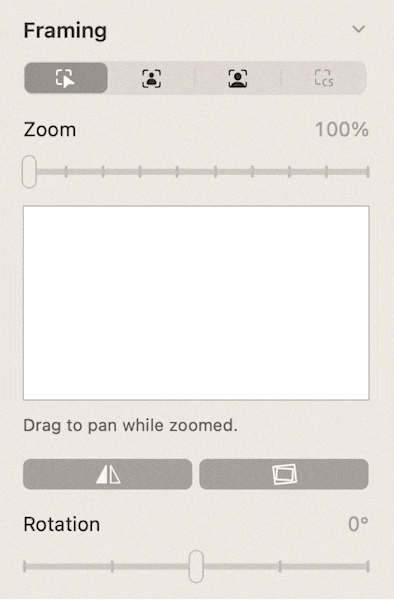Adjusting your video
Camo deliberately chooses sensible defaults when it’s first run. As such, most users can simply open Camo, select a Scene, and get started with streaming high-quality video immediately. If you want more control, Camo Studio also offers a number of options to alter or improve a user’s video.
Top controls
Camo is designed to be controlled entirely from your computer, using Camo Studio. The top bar of the interface offers a number of controls. From left to right, these are:
- Camo Studio icon (Windows): Click here to access the Personalise tool, Add-ons Gallery, and Settings, as well as to check for updates and hide or quit Camo.
- Hide/show settings and adjustments: These buttons let you open or collapse the settings and gallery bars. You'll see one of these on either end of Camo Studio - one for each column.
- Record: Use the Record function to record the camera feed directly from Camo. Clicking it once to start a recording, and again to stop and save it to the location you designate in Settings>General>Recording save location.
- Profiles (new in 2.3): This menu features the most common combinations of video resolution, frame rate and aspect ratio, categorised by use case. Users can also create and save their own custom profiles using the management tool found in Settings>Profiles.
- Pausing and resuming the camera: When your video is paused, your image disappears in Camo Studio and a blurred pause screen will appear in a video call. This can also be toggled via the
⌘ Cmd+⇧ Shift+⌥ Option+Photkey. - Notifications (Windows): This panel will display important updates as you use the app
- Settings (macOS): Click the gear icon to access Settings, open an expanded Gallery, manage your details in Personalise, and check out the available Add-ons. You can also use it find Help and advice, send direct feedback about your experience and export logs to help with troubleshooting any problems.
Video

The Video tab in the left sidebar can be used to choose and manage a connected device, apply image enhancements, and adjust its picture. Here are the different device-related options:
- Device: This lets you choose which connected device Camo should take video from. When the Multi-Camera add-on is activated and a scene with two or more video sources has been selected or created, each video source will receive its own sub-tab. Camo will remember devices for each of your Scenes.
- Lens: The lens drop-down allows phone users to select any of the front or rear-facing cameras on their device.
- Focus: This lets you use autofocus, or enable manual control to select the focus with a slider.
Image enhancements
Below the Device controls you'll find Camo’s image enhancement features. Depending on what device and computer you’re using, you’ll have access to some or all of the following modes:
- Basic: This leaves your background untouched.
- Portrait: Enabling this mode will give your background a pleasing bokeh, helping you pop out of the background and adding more depth to the image. The strength of the effect controllable by a slider.
- Privacy Blur: This cloaks your background in a diffuse blur.
- Replace: Use this as a virtual green screen to pop out your background and replace it with one of your own, or toggle on Physical Green Screen for Hue and Similarity tools, and to set thresholds for saturation and brightness.
Spotlight
The Spotlight feature is a powerful effect that will brighten the subject relative to the background. It excels in challenging lighting scenarios, such as when you are lit strongly from the back, and just a small movement of the slider will make a remarkable difference for most webcams.
Filters & LUTs
Camo comes with a library of bespoke creative and calibration LUTs - or filter presets - for you to choose from. You can activate and control the strength of a different cinematic or social media-inspired looks, or use one of the calibration filters to help you adjust your settings or optimise your image for use with a green screen.
In the LUT gallery, you can add your own presets, either by creating them or downloading them elsewhere and dragging them in. Camo supports Cube, 3DL and LUT formats. Within the gallery you can preview and compare effects, as well as reorder or group the filters as needed.
Framing and other image transformations

Camo's image transformation controls let you adjust the zoom, tilt, and pan of your video, enable image stabilisation, and toggle functionality such as video mirroring and video rotation.
- Manual zoom: The zoom slider lets you zoom in on a particular part of your feed, and you can then drag the viewport around in that zoomed view to reframe your image.
- Auto framing: Using a face-tracking physics engine, this feature will keep you in the centre of the frame as you move side to side.
- Auto framing with Zoom: This feature combines auto framing with an auto zoom function to keep your face centred in the frame during side to side movement and the same size as you move closer to or farther from your device’s lens.
- Video Stabilisation: Available for iOS devices, this tool minimises the effects of bumps and vibrations on your video. It can be especially helpful when using a slightly wobbly mount, or for particularly heavy typists.
- Smart zoom: Smart Zoom lets you zoom into your video with minimal impact on image quality. Standard digital zoom, which is what Camo uses by default, simply crops the image to a set zoom level and uses upscaling to match the desired output resolution. Smart Zoom avoids the loss in quality introduced through upscaling by using a larger initial input resolution so that the video’s resolution never dips below the targeted output resolution. You can enable Smart Zoom in Camo’s Preferences, under the General tab.
- Mirror my video: This horizontally flips your video. We'd recommend using this rather than your video app's mirroring, so that it's consistent. Some video apps incorrectly mirror your preview video, which can be confusing, whereas Camo always shows you what other people will see.
- Rotation: This lets you rotate your video feed in 90° adjustments. In almost all cases, it's better to disable orientation lock on your phone and to rotate it (In part because it's faster for the phone to handle the rotation of the video at source). However, if you're using your phone in upside-down portrait mode, using this rotation combined with mirroring can work well.
Image adjustments
In Camo Studio offers a number of tools for adjusting your image at a more granular level, with options for adjusting Exposure, ISO/Gain, White balance, Brightness, Saturation, Vibrance, Contrast and more.
Camo supports every regular control that cameras expose, and where a device isn’t natively capable of certain adjustments, it will automatically augment them with its own capabilities. Phone users will be able to turn on their device’s flash to use as a supplemental lighting source.
Image adjustments
In Camo Studio, users also have the power to adjust their image at a more granular level with sliders for adjusting Exposure, ISO/Gain, White balance, Brightness, Saturation, Vibrance, Contrast and more. For supported devices, there is also an anti-flicker tool accessed by clicking the ellipsis adjacent to Exposure's Auto toggle.
Camo supports every regular control that cameras expose, and where a device isn’t natively capable of certain adjustments, it will automatically augment them with its own capabilities. Phone users will be able to turn on their device’s flash to use as a supplemental lighting source.
Audio
The Audio tab in the left sidebar can be used to select your audio source and adjust its output. Camo also gives the choice of Stereo or Mono audio - when choosing Mono, iPhone users can select either the microphone at its base, or the one by the camera. As with camera options, different devices have different microphone options available.
On machines running macOS, the Audio tab includes a tool for adjusting audio delay in microsecond increments, as well as support for mixing in parallel input from system audio, additional connected microphones and/or individual applications. The volume levels and input delay of each channel can be individually adjusted to create a fully customised audio output for use in recordings, streaming, or the ‘Camo’ virtual microphone.
For Windows users, activating the Audio mixing add-on enables the addition of system audio as a parallel input, with independent volume adjustment for the microphone and system channels, along with Master volume control.
Feature compatibility
Camo’s broad range of functionality gives a lot of choice in how to set up and adjust your video, but if you’re using your phone as a camera, it can also require a lot of processing power from your device. Using demanding features, such as Smart Zoom, higher frame rates and resolutions, and advanced modes together would lead some devices to underperform during prolonged usage.
To account for this, and in a few cases due to technical reasons, the usage of certain modes may be incompatible with other functionality. Use the table below for guidance on what features make a good combination for your device and overall setup.
Note that if you select a mode that is unsupported by the currently in-use lens, resolution, or frame rate, Camo will automatically resolve this incompatibility by switching the lens, resolution, and/or frame rate to a compatible value.
| Functionality | Normal mode | Portrait mode | Other modes |
|---|---|---|---|
| Alternative lenses | ✅ | ❌ | ✅ |
| Frame rates up to 30 fps | ✅ | ✅ | ✅ |
| Frame rates above 30 fps | ✅ | ❌ | ❌ |
| Optimised resolutions | ✅ | ✅ | ✅ |
| Other resolutions | ✅ | ❌ | ✅ |
| Video stabilisation | ✅ | ❌ | ✅ |
| Smart Zoom | ✅ | ❌ | ❌ |
When using ultra high resolutions, like 4K, many of Camo's features will be limited due to the increased processing demands such resolutions put on your device and computer. In addition to the limited functions mentioned below, certain image adjustments are also not supported.
| Functionality | Up to 1080p | 4K and above |
|---|---|---|
| Frame rates above 30 fps | ✅ | ❌ |
| Auto framing without Zoom | ✅ | ❌ |
| Auto framing with Zoom | ✅ | ❌ |
| Center Stage | ✅ | ❌ |
| Portrait mode | ✅ | ❌ |
| Privacy Blur | ✅ | ❌ |
| Replace | ✅ | ❌ |
| Spotlight | ✅ | ❌ |
| AR modes | ✅ | ❌ |
by Henrik
Great stuff, thank you!
Is it possible, if not now maybe in the future, to switch between iPhone's various "Portrait" lights, especially "stage" lights which create virtual dark/white backgrounds?
reply by: Reincubate Support
Thank you Henrik! We're going to explore this in future releases. 🙂
by Erich Neuwirth
Is there any way to switch between the front and the back camera on iPhone and/or iPad.
(I know the back camera has the better resolution, I am just curious)
reply by: Reincubate Support
Hey Erich! Absolutely: use the
Lensdrop-down in Camo Studio. 🙂